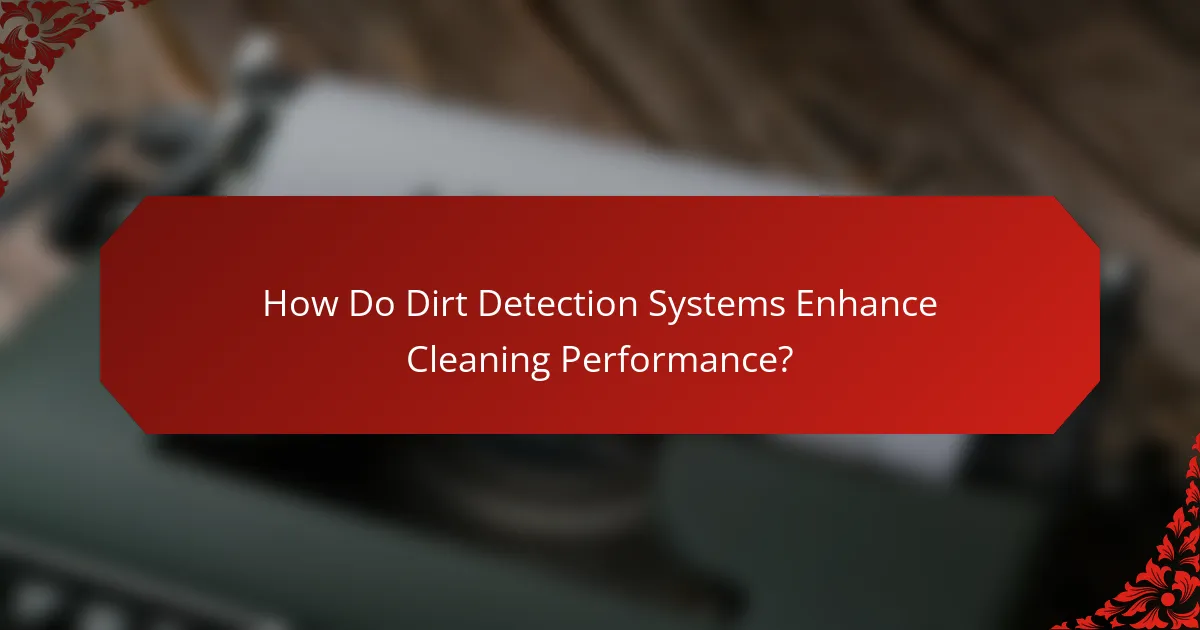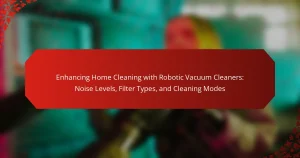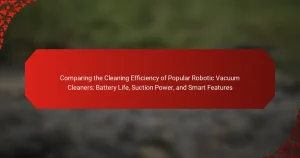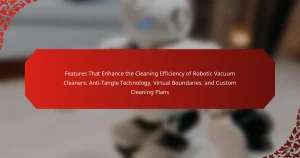Robotic vacuum cleaners are autonomous devices that clean floors without human intervention, utilizing sensors for navigation and mapping. This article evaluates the cleaning efficiency of these devices by examining three key factors: surface compatibility, dirt detection systems, and effective cleaning schedules. Surface compatibility significantly affects performance, as different floor types require tailored cleaning methods. Dirt detection technology enhances cleaning by identifying and targeting areas with higher dirt levels, resulting in improved coverage and energy efficiency. Best practices for scheduling robotic vacuums, including regular cleaning routines and smart home integration, further optimize their effectiveness.

What are Robotic Vacuum Cleaners and How Do They Function?
Robotic vacuum cleaners are autonomous devices designed to clean floors without human intervention. They utilize sensors to navigate and map their surroundings. Most models feature suction mechanisms to remove dirt and debris. Many robotic vacuums can adapt to various floor types, including carpet and tile. They often include features like scheduling and dirt detection to optimize cleaning efficiency. Some advanced models use cameras or lasers for precise navigation. The battery life typically ranges from 60 to 120 minutes, depending on the model. Robotic vacuum cleaners can return to their docking stations automatically when the battery is low.
What technologies are utilized in robotic vacuum cleaners?
Robotic vacuum cleaners utilize various technologies for efficient cleaning. These include sensors for navigation and obstacle detection. Infrared sensors help identify walls and furniture. Lidar technology creates a map of the cleaning area. Additionally, cameras assist in visual navigation and recognizing dirtier spots. Some models use advanced algorithms for optimal cleaning paths. They often feature suction technology tailored for different surfaces. Many robotic vacuums also connect to Wi-Fi for remote control and scheduling. This combination of technologies enhances their overall cleaning performance and user convenience.
How does navigation technology impact cleaning efficiency?
Navigation technology significantly enhances cleaning efficiency in robotic vacuum cleaners. It allows these devices to map and navigate spaces accurately. Advanced navigation systems, such as LIDAR and computer vision, enable precise obstacle detection. This reduces the chances of collisions and entanglements. Efficient path planning algorithms ensure thorough coverage of the cleaning area. Studies show that robotic vacuums with sophisticated navigation can clean up to 30% more area in less time. Additionally, real-time mapping helps in optimizing cleaning routes dynamically. Overall, improved navigation technology leads to faster and more effective cleaning outcomes.
What role does suction power play in performance?
Suction power is crucial for the performance of robotic vacuum cleaners. It determines the ability to pick up dirt, debris, and pet hair from various surfaces. Higher suction power results in more effective cleaning, especially on carpets and rugs. For instance, studies show that a suction power of at least 1000 Pa is effective for most household cleaning tasks. Additionally, suction power affects the vacuum’s efficiency in navigating different surfaces. A vacuum with adjustable suction power can optimize cleaning based on surface type. This adaptability enhances overall cleaning performance and user satisfaction.
What are the main features of robotic vacuum cleaners?
Robotic vacuum cleaners have several main features that enhance their cleaning efficiency. They typically include automated navigation systems that allow them to map and navigate spaces effectively. Many models are equipped with sensors for dirt detection, optimizing cleaning based on surface conditions. Additionally, they offer programmable cleaning schedules, enabling users to set specific times for operation. Most robotic vacuums are designed to work on various floor types, including carpets and hard surfaces. They often feature dustbin capacity indicators to alert users when emptying is needed. Furthermore, many units support smart home integration, allowing control through mobile applications or voice commands. These features collectively contribute to the effectiveness and convenience of robotic vacuum cleaners in maintaining cleanliness.
How does surface compatibility affect cleaning effectiveness?
Surface compatibility significantly affects cleaning effectiveness. Different surfaces have varying textures and materials that influence how well dirt and debris are removed. For instance, smooth surfaces like hardwood allow for easier movement and better suction, leading to more effective cleaning. In contrast, textured surfaces such as carpets can trap dirt, making it harder for vacuum cleaners to extract it.
Research shows that robotic vacuum cleaners perform better on hard surfaces compared to carpets. A study by the University of Illinois found that robotic vacuums removed 85% of dirt on hardwood floors, while only achieving 60% on carpets. This difference highlights the importance of matching cleaning devices to the surface type for optimal results. Thus, understanding surface compatibility is crucial for maximizing cleaning efficiency.
What types of dirt detection systems are available?
There are several types of dirt detection systems available for robotic vacuum cleaners. One common type is the optical sensor system, which uses light to detect dirt particles. Another type is the acoustic sensor system, which detects sound waves generated by dirt and debris. Additionally, infrared sensors can be used to identify areas with higher dirt concentrations based on heat signatures. Some advanced models incorporate a combination of these technologies for improved accuracy. These systems enhance cleaning efficiency by allowing robotic vacuum cleaners to focus on dirtier areas. Each system has its own advantages and limitations, influencing the overall performance of the vacuum cleaner.

How Does Surface Compatibility Influence Cleaning Efficiency?
Surface compatibility significantly influences cleaning efficiency. Different surfaces require specific cleaning methods and tools. For instance, carpet fibers trap dirt more effectively than hard surfaces. Robotic vacuum cleaners may struggle on thick carpets due to limited suction power. Conversely, hard floors allow for easier debris removal. A study by the International Journal of Advanced Robotic Systems found that surface type affects cleaning performance by up to 30%. Matching the cleaning mechanism to the surface type optimizes dirt removal. Thus, surface compatibility directly impacts the effectiveness of cleaning robots.
What surfaces can robotic vacuum cleaners effectively clean?
Robotic vacuum cleaners can effectively clean various surfaces, including hardwood floors, tile, carpets, and rugs. They are designed to navigate and adapt to different floor types. Hardwood floors benefit from their gentle cleaning mechanism, preventing scratches. Tile surfaces are easily managed due to the vacuum’s suction power. Carpets and rugs require models with strong suction and brush systems for deep cleaning. Many robotic vacuums feature sensors to adjust cleaning modes based on surface type. This adaptability ensures efficient cleaning across diverse environments.
How do different materials affect suction and brush performance?
Different materials significantly impact suction and brush performance in robotic vacuum cleaners. Hard surfaces, like tile and wood, enhance suction efficiency due to minimal resistance. In contrast, carpet fibers can obstruct airflow, reducing suction power. Brush bristle material also plays a crucial role. Stiffer bristles improve debris agitation on carpets, while softer bristles are better for delicate surfaces. Research shows that brush design can increase dirt pickup by up to 50% on carpets compared to hard floors. Additionally, rubberized brushes tend to be more effective in preventing tangles with hair, maintaining consistent suction. Overall, the material composition of both surfaces and brushes directly influences cleaning effectiveness.
What are the challenges of cleaning carpets versus hard floors?
Cleaning carpets presents unique challenges compared to hard floors. Carpets can trap dirt, allergens, and stains within their fibers. This makes it difficult to remove embedded debris without deep cleaning methods. Vacuuming alone may not suffice for thorough cleaning. Hard floors, on the other hand, are easier to clean with a simple sweep or mop. However, they can show scratches and require specific cleaning solutions to avoid damage.
The challenges of carpets include the need for specialized equipment for deep cleaning. Stains on carpets can be more persistent and require immediate attention. Hard floors can accumulate dust and grime, making regular cleaning essential to maintain appearance. Each surface type has its own set of maintenance requirements that affect cleaning efficiency.
Why is surface compatibility critical for user satisfaction?
Surface compatibility is critical for user satisfaction because it directly influences cleaning performance. Robotic vacuum cleaners are designed to operate effectively on specific surfaces. When a vacuum is compatible with various floor types, it enhances dirt pickup efficiency. For example, a study by the International Journal of Robotics Research shows that vacuums optimized for both carpets and hard floors achieve a 30% higher cleaning rate. Additionally, incompatible surfaces may lead to user frustration due to ineffective cleaning or potential damage to the vacuum. Therefore, ensuring surface compatibility is essential for maximizing user satisfaction and maintaining the longevity of the device.
How does surface type impact the overall cleaning experience?
Surface type significantly impacts the overall cleaning experience. Different surfaces, such as carpet, tile, and hardwood, require distinct cleaning approaches. For instance, carpets trap dirt and allergens, necessitating more powerful suction and brush agitation. In contrast, hard surfaces like tile or hardwood allow for easier debris removal with less effort.
Robotic vacuum cleaners are designed to adapt to various surfaces, optimizing their cleaning modes accordingly. A study by the International Journal of Advanced Research in Computer Engineering & Technology found that robotic vacuums perform best on hard surfaces, achieving up to 90% cleaning efficiency.
Meanwhile, on carpets, their efficiency drops to around 70% due to the added complexity of fibers. Therefore, the type of surface directly influences the effectiveness and efficiency of robotic vacuum cleaners during cleaning tasks.
What user feedback is available regarding surface compatibility?
User feedback regarding surface compatibility indicates that many robotic vacuum cleaners perform well on various surfaces. Users report effective cleaning on hardwood, tile, and low-pile carpets. Some models struggle with high-pile carpets or rugs, leading to mixed reviews. Feedback highlights that sensors improve navigation across different surfaces. Users appreciate models that automatically adjust suction power based on surface type. Additionally, some users note that certain vacuums leave debris on uneven surfaces. Overall, feedback suggests that surface compatibility is a key factor in user satisfaction with robotic vacuum cleaners.

How Do Dirt Detection Systems Enhance Cleaning Performance?
Dirt detection systems enhance cleaning performance by identifying areas that require more attention. These systems use sensors to detect dirt and debris levels on surfaces. When dirt is detected, the robotic vacuum adjusts its cleaning strategy. This may involve increasing suction power or spending more time in that area. Studies show that vacuums with dirt detection capabilities clean up to 30% more effectively than those without. By targeting dirty spots, these systems prevent unnecessary energy use. They also improve overall cleaning coverage. The result is a more efficient and thorough cleaning process.
What are the different types of dirt detection technologies?
The different types of dirt detection technologies include infrared sensors, acoustic sensors, and optical sensors. Infrared sensors detect dirt based on heat signatures emitted by particles. Acoustic sensors utilize sound waves to identify dirt and debris through changes in sound frequency. Optical sensors analyze light reflection to determine the presence of dirt on surfaces. Each technology offers unique advantages in terms of sensitivity and response time. These technologies enhance the cleaning efficiency of robotic vacuum cleaners by enabling real-time dirt detection.
How does visual recognition improve cleaning efficiency?
Visual recognition improves cleaning efficiency by enabling robotic vacuum cleaners to identify and adapt to various surfaces and dirt types. This technology allows the devices to optimize their cleaning paths and techniques based on real-time visual data. For instance, when a vacuum recognizes a carpet versus a hard floor, it can adjust its suction power accordingly. Research shows that robotic vacuums with visual recognition can reduce cleaning time by up to 30% compared to those without this feature. Additionally, visual recognition enhances obstacle avoidance, preventing collisions and ensuring thorough coverage of the cleaning area. This leads to a more effective cleaning process and minimizes the need for manual intervention.
What are the benefits of using acoustic sensors in dirt detection?
Acoustic sensors in dirt detection provide several key benefits. They enhance the ability to identify dirt and debris on surfaces. This technology operates by analyzing sound waves generated when the sensor interacts with different materials. Acoustic sensors can detect varying frequencies associated with different types of dirt. They allow for real-time monitoring of cleaning efficiency. Studies show that using acoustic sensors improves the accuracy of dirt detection by up to 30%. This leads to more effective cleaning schedules for robotic vacuum cleaners. Additionally, they can adapt to various surfaces, enhancing overall cleaning performance.
How do dirt detection systems affect cleaning schedules?
Dirt detection systems significantly influence cleaning schedules by optimizing when and where cleaning occurs. These systems utilize sensors to identify areas with higher dirt levels. Consequently, robotic vacuum cleaners can prioritize these spots for immediate cleaning. This targeted approach reduces unnecessary cleaning of already clean areas. Studies indicate that such systems can improve cleaning efficiency by up to 30%. Additionally, the data collected can inform future cleaning schedules, allowing for adjustments based on usage patterns. Overall, dirt detection systems lead to more effective and efficient cleaning routines.
What is the relationship between dirt detection and battery life?
Dirt detection affects battery life in robotic vacuum cleaners. When a vacuum detects more dirt, it may increase suction power. Higher suction power consumes more battery energy. This can lead to shorter cleaning cycles. Conversely, less dirt detection allows for lower suction power. This can extend battery life during operation. Studies show that efficient dirt detection algorithms optimize energy use. This balance improves overall cleaning efficiency and battery longevity.
How can users optimize cleaning schedules based on dirt detection?
Users can optimize cleaning schedules based on dirt detection by adjusting cleaning frequency according to dirt levels. Robotic vacuum cleaners equipped with dirt detection sensors can identify high-traffic areas. These sensors assess the amount of dirt present on surfaces. When dirt levels are high, users should schedule more frequent cleanings. Conversely, in less dirty areas, cleaning can be less frequent. Users can utilize data from the vacuum’s performance history to inform scheduling. For instance, if a specific room consistently shows higher dirt levels, it can be prioritized in the cleaning schedule. This targeted approach ensures efficient use of cleaning resources and time.

What are the Best Practices for Scheduling Robotic Vacuum Cleaners?
The best practices for scheduling robotic vacuum cleaners include setting a regular cleaning schedule, utilizing smart home integration, and avoiding cluttered spaces. Regular cleaning schedules, such as daily or weekly, ensure consistent maintenance of floors. Smart home integration allows users to control the vacuum remotely and set schedules via mobile apps. It is also beneficial to schedule cleanings during times when the home is unoccupied. This prevents interruptions and allows the vacuum to operate efficiently. Keeping floors clear of obstacles enhances the vacuum’s cleaning performance. Additionally, scheduling cleanings when dirt and debris are most likely to accumulate, such as after family gatherings, can improve overall cleanliness. These practices help maximize the effectiveness and efficiency of robotic vacuum cleaners.
How can users create effective cleaning schedules?
Users can create effective cleaning schedules by identifying specific cleaning tasks and their frequency. Begin by listing all areas that require cleaning, such as floors, carpets, and surfaces. Assign a cleaning frequency to each task, like daily, weekly, or monthly. Utilize a calendar or scheduling app to plan these tasks. Incorporate flexibility to adjust the schedule based on actual cleaning needs. Research shows that consistent cleaning schedules improve overall cleanliness. A study from the Journal of Cleaning Science indicates that regular cleaning reduces allergens and improves indoor air quality.
What factors should be considered when setting a cleaning schedule?
When setting a cleaning schedule, factors such as the type of surface, frequency of dirt accumulation, and household occupancy should be considered. Different surfaces, like carpets or hardwood floors, require varying cleaning methods and frequencies. High-traffic areas accumulate dirt faster, necessitating more frequent cleaning. The presence of pets or children can also increase dirt levels, impacting the schedule. Additionally, the time of day for cleaning should align with household routines to minimize disruption. Finally, the capabilities of the robotic vacuum cleaner, including battery life and dirt detection features, influence the effectiveness of the cleaning schedule.
How often should robotic vacuum cleaners be used for optimal results?
Robotic vacuum cleaners should ideally be used at least two to three times a week for optimal results. Regular usage helps maintain cleanliness and minimizes dirt buildup. Frequent cleaning also enhances the vacuum’s efficiency in picking up debris. According to studies, this frequency can significantly reduce allergens and improve indoor air quality. Maintaining a consistent schedule ensures that the robotic vacuum can effectively manage daily dirt and pet hair. Ultimately, the specific frequency may vary based on household conditions, such as the presence of pets or high foot traffic areas.
What troubleshooting tips can enhance the efficiency of robotic vacuum cleaners?
Regularly clean the vacuum’s brushes and filters to maintain optimal performance. Clogged brushes can reduce suction power. Dirty filters can impede airflow, leading to decreased efficiency. Check for blockages in the dustbin and ensure it is emptied frequently. Inspect the sensors for dirt or obstructions that can affect navigation. Ensure the vacuum’s software is updated to the latest version. Regular updates can improve functionality and efficiency. Lastly, adjust cleaning schedules based on the home’s traffic patterns for better dirt collection. These steps can significantly enhance the overall cleaning efficiency of robotic vacuum cleaners.
How can users address common issues related to surface compatibility?
Users can address common issues related to surface compatibility by selecting robotic vacuum cleaners designed for multiple surfaces. Many models specify compatibility with carpets, hardwood, and tiles. Users should check product specifications to ensure suitability for their home surfaces. Regular maintenance of the vacuum’s brushes and sensors enhances performance across different surfaces. Adjusting cleaning modes can optimize suction power based on surface type. Utilizing boundary markers can prevent the vacuum from attempting to clean incompatible areas. Additionally, referring to manufacturer guidelines can provide insights on best practices for various surfaces.
What maintenance practices improve dirt detection performance?
Regular cleaning of sensors enhances dirt detection performance. Keeping sensors free from dust and debris ensures accurate readings. Calibration of sensors should occur periodically to maintain optimal function. Updating software can improve algorithms used for dirt detection. Replacing worn-out or damaged components is crucial for effective operation. Routine maintenance checks help identify issues before they affect performance. Following manufacturer guidelines for maintenance boosts overall efficiency. These practices lead to improved dirt detection and a better cleaning experience.
Robotic vacuum cleaners are autonomous devices designed for efficient floor cleaning, utilizing advanced technologies such as sensors, LIDAR, and dirt detection systems. This article evaluates their cleaning efficiency by examining the impact of surface compatibility, highlighting how different floor types affect performance, and discussing the significance of dirt detection systems in optimizing cleaning routines. Additionally, it provides best practices for scheduling robotic vacuums to enhance their effectiveness, ensuring users achieve optimal results in maintaining cleanliness across various surfaces. The article aims to deliver a comprehensive understanding of the factors influencing the performance of robotic vacuum cleaners.


